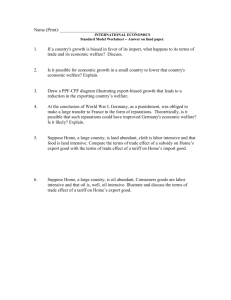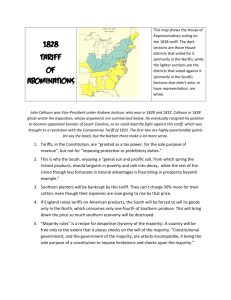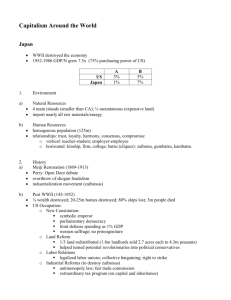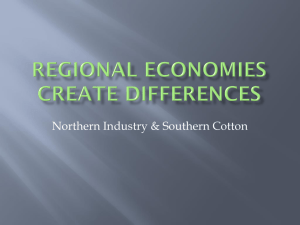Sample Midterm Exam Solutions
advertisement
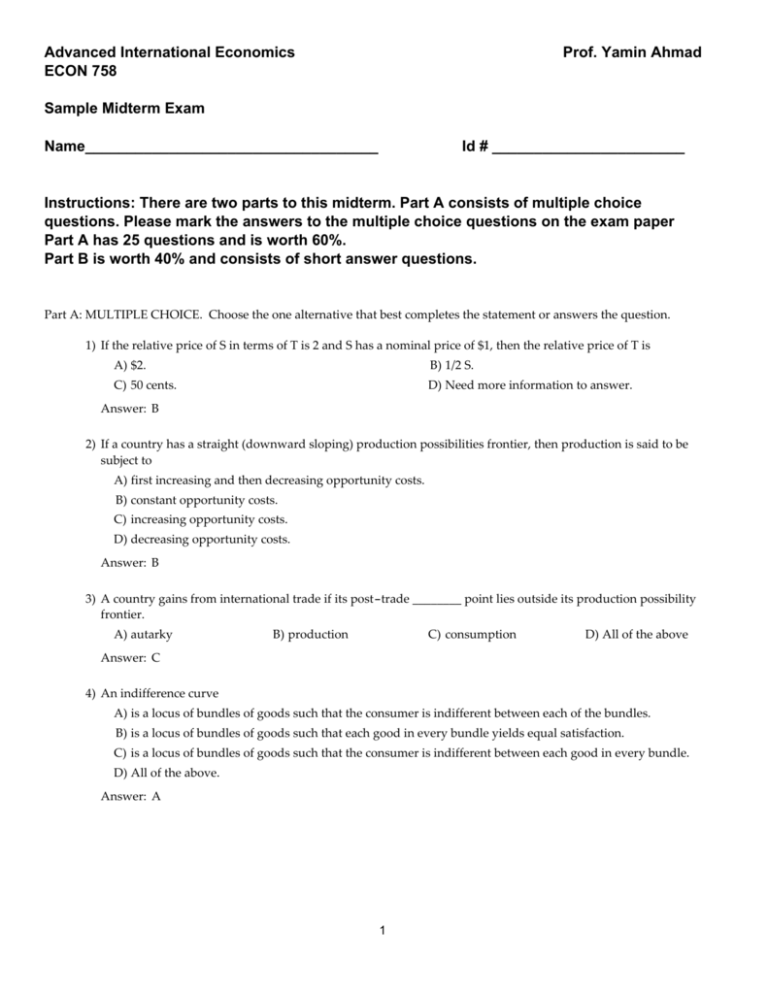
Advanced International Economics ECON 758 Prof. Yamin Ahmad Sample Midterm Exam Name___________________________________ Id # _______________________ Instructions: There are two parts to this midterm. Part A consists of multiple choice questions. Please mark the answers to the multiple choice questions on the exam paper Part A has 25 questions and is worth 60%. Part B is worth 40% and consists of short answer questions. Part A: MULTIPLE CHOICE. Choose the one alternative that best completes the statement or answers the question. 1) If the relative price of S in terms of T is 2 and S has a nominal price of $1, then the relative price of T is A) $2. B) 1/2 S. C) 50 cents. D) Need more information to answer. Answer: B 2) If a country has a straight (downward sloping) production possibilities frontier, then production is said to be subject to A) first increasing and then decreasing opportunity costs. B) constant opportunity costs. C) increasing opportunity costs. D) decreasing opportunity costs. Answer: B 3) A country gains from international trade if its post-trade ________ point lies outside its production possibility frontier. A) autarky B) production C) consumption D) All of the above Answer: C 4) An indifference curve A) is a locus of bundles of goods such that the consumer is indifferent between each of the bundles. B) is a locus of bundles of goods such that each good in every bundle yields equal satisfaction. C) is a locus of bundles of goods such that the consumer is indifferent between each good in every bundle. D) All of the above. Answer: A 1 Answer the question(s) below based on the following diagram. 5) Refer to the figure above. In autarky equilibrium, the relative price is given by the slope of the production possibility frontier at point A) F. B) D. C) E. D) Canʹt answer without more information. Answer: C 6) The classical theory predicts that A) considerable trade will occur between countries with different levels of technology. B) small countries could obtain all of the gains from trade when trading with large countries. C) countries will completely specialize in the production of export goods. D) All of the above. Answer: D 7) The labor theory of value A) says that wages must always be greater than prices. B) is what economists believe determines prices today. C) says that the price of a good is determined by the amount of labor required to produce it. D) All of the above. Answer: C 2 Answer the question(s) below based on the information in the following table, where the numbers represent the number of labor hours it will take to produce a unit of the given good Spain 3 1 Grapes Textiles France 9 2 The numbers represent the number of labor hours it will take to produce a unit of the given good. 8) Refer to the table above. France has absolute advantage in A) grapes. B) textiles. C) both grapes and textiles. D) neither grapes nor textiles. Answer: D 9) Refer to the table above. Spain has comparative advantage in A) textiles. B) grapes. C) both grapes and textiles. D) neither grapes nor textiles. Answer: B 10) Absolute advantage is determined by A) relative differences in labor productivity between countries. B) actual differences in labor productivity between countries. C) Both A and B. D) Neither A nor B. Answer: B Answer the question(s) below based on the following diagram of a country that is in international trade equilibrium. 11) Refer to the figure above. This countryʹs imports equal A) GH units of Y. B) CD units of X. C) DE units of Y. Answer: A 3 D) CE units of X. 12) The HO model assumes that ________ are identical between countries. A) tastes B) factor endowments C) technology sets D) Both A and B Answer: D 13) Let Kj and L j denote the capital and labor stocks of country j (j=A,B), then A is said to be capital abundant relative to B if A) LA < LB. C) KA/LA > KB/LB. B) KA > KB. D) All of the above. Answer: C Answer the question(s) below based on the following diagram of a country that is in international trade equilibrium. 14) Refer to the figure above. If Y is labor intensive then according to the HO theory, this country should be ________ abundant. A) capital B) labor C) both capital and labor D) Canʹt tell without more information Answer: A 15) Refer to the figure above. This countryʹs exports equal A) DE units of Y. B) CD units of X. C) GH units of Y. Answer: B 4 D) CE units of X. Answer the question(s) below based upon the following diagram. 16) Refer to the figure above for a small open economy. With the tariff, the government collects A) $150,000. B) $100,000. C) $60,000. D) $220,000. Answer: A 17) Refer to the figure above. With the tariff, the quantity of imports falls to A) 12,000 units. B) 30,000 units. C) 50,000 units. D) 42,000 units. Answer: B 18) Refer to the figure above. With free trade, the total value of imports would equal A) $100,000. B) $300,000. C) $500,000 D) $10. Answer: C 19) A tariff can ________ raise a countryʹs welfare. A) always B) sometimes C) never Answer: B 20) Most tariffs have A) only revenue effects. B) only protective effects. C) both protective and revenue effects. D) neither protective nor revenue effects. Answer: C 21) Which of the following are used as nontariff barriers? A) government procurement policies B) health and safety standards C) domestic content laws D) All of the above Answer: D 5 Answer the question(s) below based on the following diagram. 22) Refer to the figure above. Quota rents equal A) $10000. B) $2000. C) $5000. D) $6000. Answer: D 23) Like tariffs, quotas tend to lead to A) higher prices and reduced imports. B) increased consumer surplus. C) increased government revenue. D) All of the above. Answer: A 24) Which of the following is an invalid argument for protection? A) redistribution of income B) preservation of the home market C) infant industry protection D) All of the above Answer: B 25) Quotas are government imposed limits on the ________ of goods traded between countries. A) prices B) quantity C) value Answer: D 6 D) Either B or C Part B: SHORT ANSWER QUESTIONS (40%) Please answer the following short answer questions. For essay type questions, please keep your answers for each question to a length of one page. Points are awarded for the succinctness, consistency and clarity of your answer. You will not get points for verbosity. Feel free to use graphs (as they apply) to help elucidate your answer. Show any calculations as necessary in answering the questions. 26. (10%) Suppose that the world consists of two countries only. Use General Equilibrium diagrams for both countries to show that they gain from trade. Briefly explain why trade benefits residents of both countries. Answer: The answer I am looking for here can be found in the lecture notes. T T M TOT(|slope|=PS/PT) I L N R K SIC2A SIC1B SIC1B A SIC1 TOT(|slope|= PS/PT) H J S S Country A Country B With trade, world production of both goods rise. Thus each country is able to expand its consumption set. The terms of trade determine the new consumption possibility frontier and as a result, the citizens of both countries are able to reach a higher indifference curve which leads to greater economic welfare. Hence trade benefits residents of both countries. 27. (10%) Within the Heckscher-Ohlin framework, assume that good X is capital intensive and good Y labor intensive. Consider the capital abundant country. (i) [4 pts] Using the diagram below, draw a representative PPF for this country. Mark a candidate production point and label it E0. 7 Answer: Y TOT Y0 E0 E1 Y1 X0 X1 X (ii) [6 pts] In the diagram above, now show what happens if the capital stock in the country rises. Mark another candidate production point that reflects the change that occurred (in terms of a higher capital stock) and label this point E1. What happens to the PPF, the production point E0 and production of goods X and Y as a result of the increase in capital stock? Answer: This is the Rybczynski Theorem. The thing that is changing here is the endowment of capital in the country. The world price remains fixed, and so the Rybczynski theorem would state that the country would produce more of the good that is intensive in the factor that has risen, and less of the other good. Since good X is capital intensive and good Y labor intensive, a rise in the stock of capital means that we produce more of the capital intensive good, i.e. X, and less of the labor intensive good, i.e. Y. 28. (20%) Use your knowledge about trade policy to evaluate the following statement: “Tariffs have a more negative effect on welfare in large countries than in small countries.” Answer: This question is looking to see if you understand and can explain the difference between imposing a tariff in a large country vs. a small country. Answers should note that a tariff in either type of country would raise the price at home for that product leading domestic producers to supply more and domestic consumers to demand less. Hence imports would fall for both types of countries. However, this is where the similarity ends. 8 Model answers would note that the difference between a large country and a small country is that a tariff in a small country has no impact on the world price of a good since its demand for the good is an insignificant part of world demand. However, a large country can impact the world price for the good, and although by imposing a tariff, the domestic price rises, the world price falls, until the difference between the two equals the amount of the tariff. Thus a large country is able to pass on a part of the burden of the tariff to the exporting country. In terms of economic welfare, the losses from a tariff are the producer and consumer deadweight losses (areas b and d in the diagram below). Both types of countries (i.e. large and small), gain area c in terms of additional government revenue. However the large country also gains area e, which represents the terms of trade gain. Thus the statement above is false since large countries are better off than smaller countries in terms of welfare gains. [Note, even with the government gaining areas c and e, these might be insufficient to offset the losses from b and d. Thus the overall effect in terms of welfare for a large country is ambiguous!] 9
